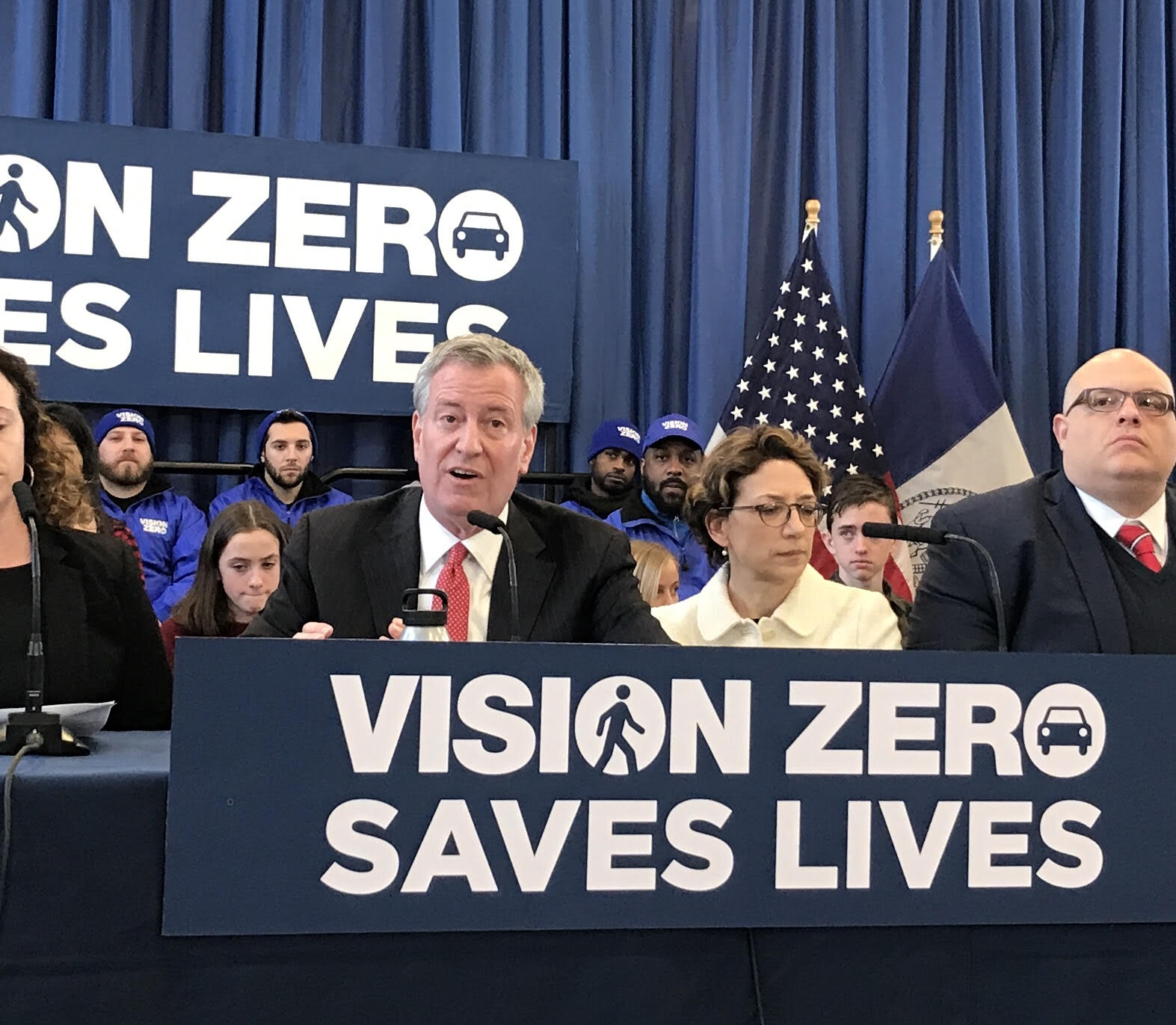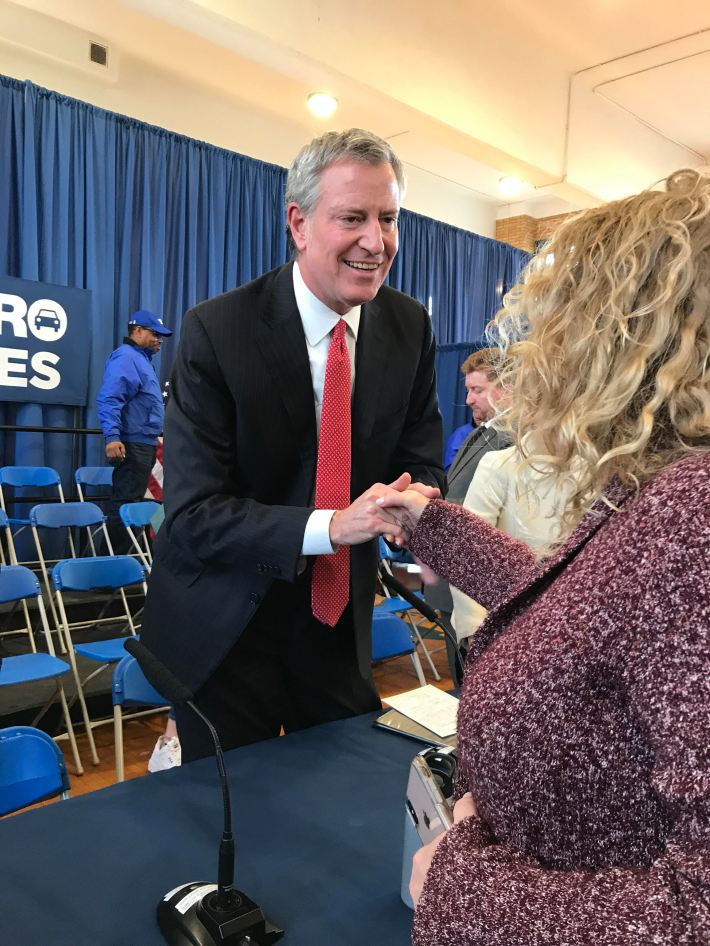Meet the new pedestrian safety plan — better than the old pedestrian safety plan?
Mayor de Blasio released the city's 2019 "Borough Pedestrian Safety Plans" on Tuesday, pledging to double-down on some proven successes of his five-year-old Vision Zero campaign with a mix of new and old strategies for the most-dangerous roadways.
City officials said roughly seven percent of the city's roadways are the site of 50 percent of the crashes that kill or severely injure pedestrians. Those roadways comprise the 424 miles of new "priority corridors" going forward.
"We've been addressing a lot of the biggest problems," de Blasio said. "Now we want to go a lot deeper. ... It's about drilling down, targeting each street that needs more work. It's a lot like precision policing, which if you will look at the history of the NYPD, if you look at CompStat, if you look at how crime got driven down, it tells you a lot about how we're going to do this with Vision Zero as well. We're focusing where the problem is, more and more, putting the changes in place."
The primary focus for pedestrians will be the installations of thousands more "leading pedestrian intervals," which give walkers a head start over drivers, and a commitment to build at least 50 "Vision Zero safety engineering improvements" annually — both strategies that proved successful in the 2015 version of the plans. The city will also retime traffic lights to discourage speeding on the "priority corridors" as it has done on many arterials.
A press release from the mayor's office touted some successes from the first pedestrian plans [PDFs], including a 50-percent reduction in pedestrians killed or seriously injured on Baychester Avenue from Hammersley Avenue to Hoxie Street in the Bronx; a 50-percent reduction in such deaths and injuries on Bushwick Avenue from Maspeth Avenue to Jamaica Avenue in Brooklyn; and a 30-percent reduction in pedestrians killed or seriously injured on Hillside Avenue from Myrtle Avenue to Langdale Street in Queens.
And he also touted statistics showing that overall traffic fatalities are down in the Vision Zero era, to a record 201 last year.
But the problem of road safety is much deeper than small numerical declines in cyclist and pedestrian deaths. The city is in the sixth year of de Blasio's Vision Zero initiative, but pedestrian are still being injured by drivers in terrifyingly huge numbers.
In 2015, for example, 10,082 pedestrians were injured by drivers. Last year, the number was 11,011, up 9.2 percent.
Overall, pedestrian injuries are up in every borough except Manhattan, with the Bronx up 10.6 percent, Brooklyn up 10.2 percent and Queens up 7.8 percent last year versus 2015.
And seven more pedestrians were killed last year — 114 — than the year before.
It is not for lack of effort by the Department of Transportation. Since 2014, the city has converted nearly 3,000 intersections to give pedestrians a head-start against cars, issued more than five million speeding tickets by camera (and more than 910,000 by cops during the same period), and completed 461 safety engineering projects, city officials said. Police-written summonses are up dramatically under de Blasio.
The release of the new strategies comes after a very bad January for cyclists and pedestrians, though officials said it has been in the works for many months.
This time around, the city said its "new Priority Corridors" are:
- Bronx: Westchester Avenue (Third Avenue to Bronx River Avenue); Boston Road (Third Avenue to Bronx Park East); Soundview Avenue (White Plains Road to Bruckner Boulevard)
- Brooklyn: Linden Blvd (Flatbush Avenue to Sapphire Street); Eighth Avenue (39th Street to 73rd Street); Surf Avenue (Ocean Parkway to the Sea Gate border); Bedford Avenue (Manhattan Avenue to Flatbush Avenue).
- Manhattan: Columbus Avenue (59th Street to 110th Street)' York Avenue (60th Street to 91st Street at the FDR); 10th Avenue (14th Street to 59th Street)
- Queens: Rockaway Boulevard (Eldert Lane to 3rd Street); 37th Avenue (114th Street to Woodside Avenue); 21st Street (50th Avenue to 20th Avenue)
- Staten Island: Targee Street (Van Duzer Street to Richmond Road); Bradley Avenue (Watchogue Road to Brielle Avenue); Lincoln Avenue (Richmond Road to Father Capodanno Boulevard)
City officials said they chose the priority routes based on crash data.
That said, the plan does not explicitly call for radical solutions, such as widespread pedestrian-only zones, such as Times Square. And de Blasio has rejected calls to create car-free zones, as has been done in London, Paris, Madrid and other world capitals.
At Tuesday's announcement, State Senator Andrew Gounardes and City Council Member Justin Brannan both mentioned the need for changing a culture dominated by the automobile, but de Blasio would not commit to breaking the car culture by asking drivers to make sacrifices such as putting some streets or whole regions of the city off-limits to automobiles. He also declined to strongly support congestion pricing.
"I’ve made it very clear ... that I think there are other things that are even more promising [than congestion pricing]," the mayor started. "On the question of closing our streets, look, I would argue on first blush, I’m not the expert, the Commissioner is, but I think right now, we’re trying to sort of do things in sequential order. We’ve got an MTA problem we have to fix, we’ve got a congestion problem we have to fix, and we’re going to be seeing a lot more on that soon, because we’ve put some pilots in place, and it’s time to talk about what we’re now going to do as a result of those. In my view, closing our streets is kind of contradictory to some of the other things we’re trying to address right now. But I don’t rule it out as a future strategy. I just don’t think it’s the immediate thing we should be doing."
DOT Commissioner Polly Trottenberg suggested that more streets would be reconfigured as "shared" zones, with extremely low speed limits.
"I don’t want to brag about having a plan that makes life miserable for people behind the wheel, but I actually think there’s a lot in here which is trying to change the balance of the streets to again focus on pedestrians, on cyclists," she said. "We do talk a bit about the shared street concept, which we’ve started in the Flatiron district and I think we’re going to try and bring more of that into the city this year, which is allowing some local access for local businesses and residents, but otherwise making it a street that’s very much for pedestrians and cyclists and hopefully people do enjoy the space."
Later, Streetsblog tried again to get the mayor to commit to a more aggressive approach, which led to this faux-heated exchange:
Streetsblog: You're not a pedestrian. You're not a cyclist, very typically, Mr. Mayor —
Mayor de Blasio: I'm a pedestrian often, Gersh, respectfully —
Streetsblog: With all due respect —
Mayor: Respectfully, Gersh and I are going to have a fight. I have been a pedestrian, a lot, Gersh. You got to give me that.
Streetsblog: But more recently...?
Mayor: I still walk, Gersh.
Streetsblog: The plan does not call for —
Mayor: They have not taken away my right to cross the street and walk the streets. Continue.
Streetsblog: I will continue. So the plan did not call for a dramatic expansion in protected bike lanes, which we know makes roadways safer for pedestrians, cyclists, and drivers. You may not aware of it, but painted bike lanes, which you are expanding dramatically across the city, tend to become double-parking or illegal-parking zones. Why not call for – as members of the Council have called for — a dramatic expansion of protected bike lanes?
Mayor: Look, we're doing a lot of different things. Polly can give you a more erudite answer but I'll give you the common sense answer. We're doing a lot of things. We're doing them rapidly and it depends on the location and what we think is appropriate overall, but we've also been really clear. I want to make this point about the changing nature of things. Every year that the NYPD drives down crime allows for more focus on other types of enforcement. Very clear message to the NYPD, very clear message to DOT that we expect there to be enforcement in bike lanes. So that's something I think you'll see more and more of. We don't want people blocking up the bike lanes but it depends on the location which approach we're going to take.
Trottenberg added that she could take up Council Member Ydanis Rodriguez's "aggressive" challenge if she got buy-in from every member of the Council — in whose districts those lanes would be located.
Yup, he is a pedestrian from His SUV to the gym, I have seen it myself...
— Shmuli Evers (@Shmuli) February 19, 2019
He's a pedestrian the same way painted bike lanes are referred to as "protected"
— Esthi Zipori (@EsthiZipori) February 19, 2019
Council Member Brannan has said he would support street safety improvements in his Bay Ridge district. In a statement, he also kept the focus of Tuesday's announcement where it needed to be, and where the mayor declined to direct it fully.
“Unfortunately, there is no known antidote for the driver who gets behind the wheel of their SUV and thinks they are the only person on the planet who matters," he said, calling for "every tool at our disposal to improve conditions for pedestrians of all ages and ability."







